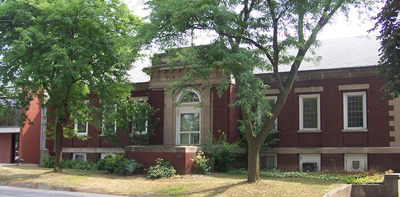Carnegie Building
Formed in November 1824, the Welland Public Library is perhaps the oldest continuously operating institution in the City of Welland. In the centuries since its founding, the library has continued to grow. The first librarian, hired in 1867, was Bertha Hooker, and the first municipal grant received from the Town of Welland was $25 in 1885.
Around 1910, Welland was interested in obtaining a Carnegie library grant. As a result, Carnegie and his charitable foundation, the Carnegie Corporation, would build six public libraries in the Niagara Region.
Welland received a Carnegie grant in 1913 but did not pass the by-law authorizing library maintenance until February 1922. A lot on King Street was purchased for $8,000. After the Carnegie library was completed in 1923, the Welland Public Library continued to expand its services. The library operated from the Carnegie building until moving to Civic Square in 2005.
Designed by local architect Norman Kearns, who was responsible for the market building, the library was constructed in the style of Beaux-Arts Classicism typical of most Carnegie libraries. A single-story building with an exposed basement, it is built of dark red Milton brick with ornamental details in contrasting buff Indiana limestone.
These details include prominent cornerstones, window lintels and sills, a string course dividing the basement from the first floor, and classical detailing on the prominent central vestibule. This vestibule has a doorcase since converted to a window, surmounted by a semicircular window and flanked by two monumental stone pilasters topped with Ionic-style spirals decorated with an egg and dart pattern. Above these is a wide stone inscribed with the words public library. Centrally located above this is the City of Welland’s crest, a lion rampant flanked by two ships.
Inside, some of the original mahogany trim remains. A wide cornice punctuated by scrolled brackets survives on the main floor, along with a portion of dado moulding on the west wall and on top of the windows. Ceiling mouldings in the basement are also supported by decorative brackets. After numerous alterations, including large additions in 1961 and 1974 to 1975, the character of the Carnegie library remains evident in the original building’s exterior.
Contact
- Heritage Advisory Committee
- Civic Square,
60 East Main St., Welland, ON L3B 3X4 - info@wellandheritage.ca
